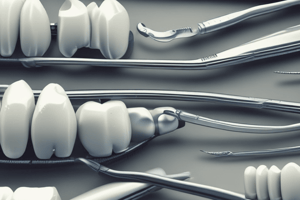Podcast
Questions and Answers
Why did Grossman emphasize the importance of using a rubber dam during endodontic treatment?
Why did Grossman emphasize the importance of using a rubber dam during endodontic treatment?
- To avoid legal implications and potential lawsuits. (correct)
- To prevent the ingestion or aspiration of instruments during treatment.
- To ensure proper retraction of soft tissues during the procedure.
- To provide moisture control and visibility in the operating field.
What is the main purpose of a rubber dam in endodontic procedures?
What is the main purpose of a rubber dam in endodontic procedures?
- To prevent tissue damage. (correct)
- To create a hole for asthmatic patients to breathe.
- To avoid allergic reactions to latex.
- To minimize mouth breathing.
Why should a non-latex rubber dam material be used for patients with latex allergies?
Why should a non-latex rubber dam material be used for patients with latex allergies?
- To prevent psychological intolerance in patients.
- To prevent allergic reactions in latex-sensitive individuals. (correct)
- To allow mouth breathers to breathe comfortably.
- To avoid creating pressure marks on the frame.
In what situations should a hole be created in the rubber dam during endodontic treatment?
In what situations should a hole be created in the rubber dam during endodontic treatment?
What can be a consequence if an endodontic instrument escapes and is ingested during treatment without a rubber dam?
What can be a consequence if an endodontic instrument escapes and is ingested during treatment without a rubber dam?
What is the primary benefit of using a rubber dam in maintaining an aseptic environment during endodontic procedures?
What is the primary benefit of using a rubber dam in maintaining an aseptic environment during endodontic procedures?
Why is it important to provide moisture control during endodontic treatment?
Why is it important to provide moisture control during endodontic treatment?
What could happen if a partially erupted tooth does not receive a retainer during endodontic treatment?
What could happen if a partially erupted tooth does not receive a retainer during endodontic treatment?
Flashcards are hidden until you start studying



